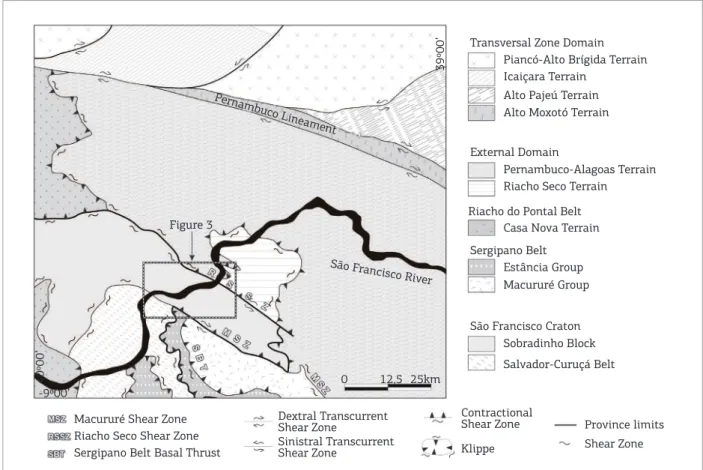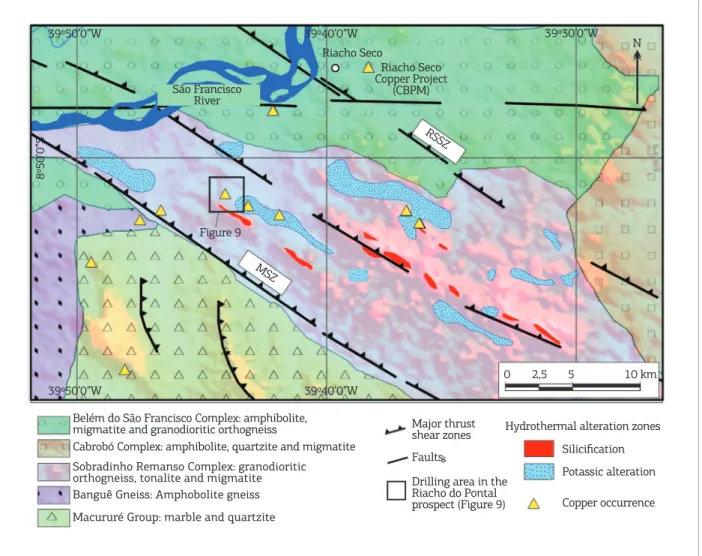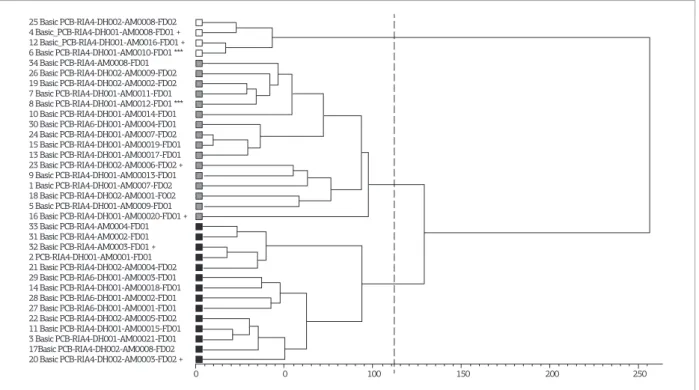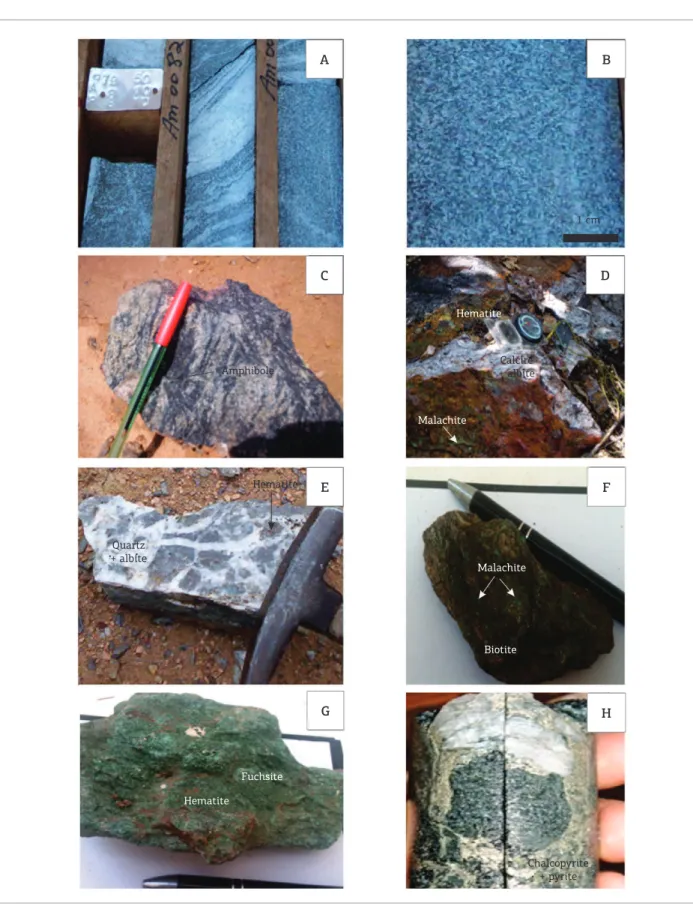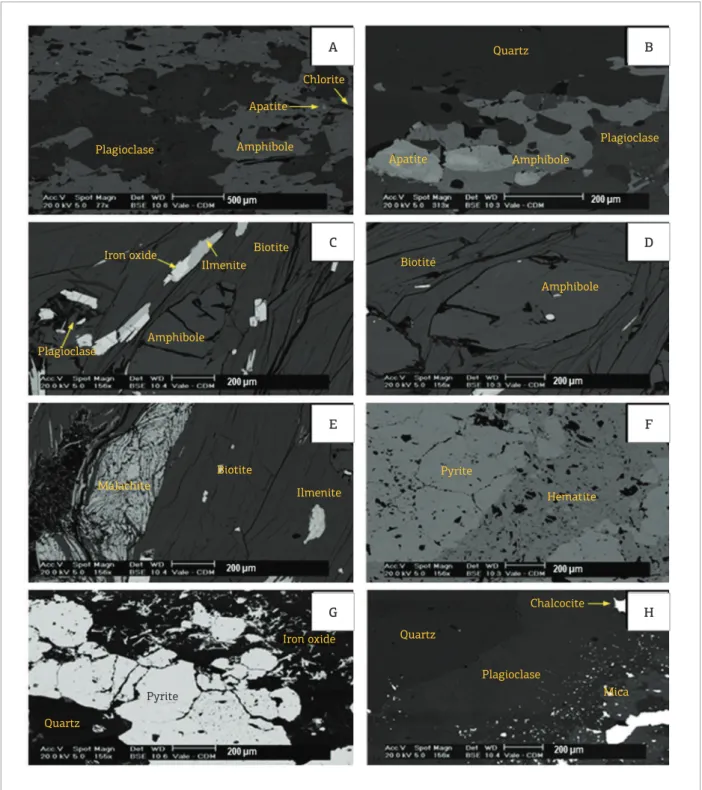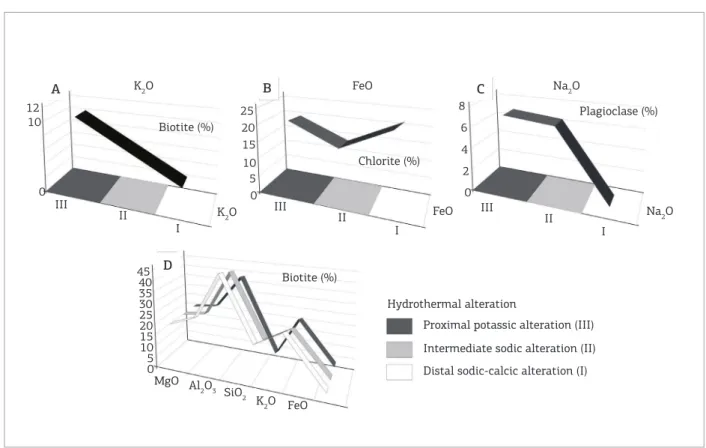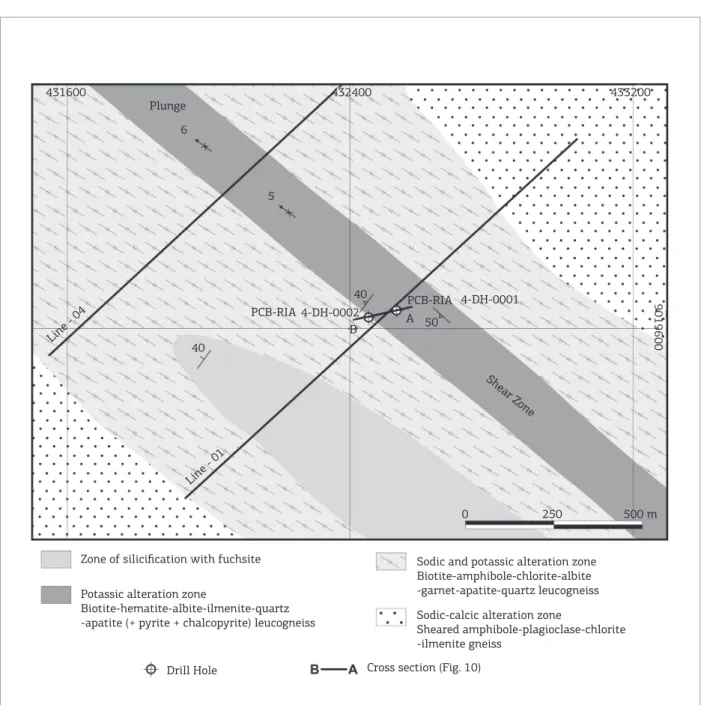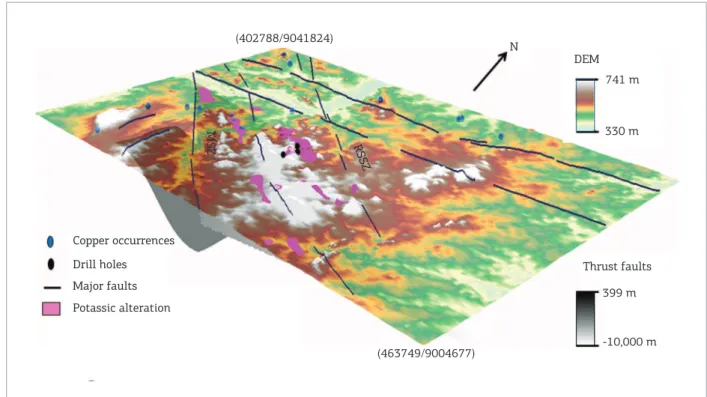1Departamento de Desenvolvimento de Projetos Minerais, Gerência Geral de Exploração, Vale S/A, Belo Horizonte (MG), Brasil. E-mails: sergio.bacelar@vale.com.br; marcelo.sousa@vale.com
2Instituto de Geociências, Universidade Estadual de Campinas - UNICAMP, Campinas (SP), Brasil. E-mail: beto@ige.unicamp.br 3Instituto de Geociências, Universidade de São Paulo - USP, São Paulo (SP), Brasil, E-mail: lena.monteiro@usp.br
*Autor correspondente
Manuscrito ID 30102. Recebido em: 02/04/2014. Aprovado em: 26/06/2014. ABSTRACT: he Riacho do Pontal prospect is situated on the border between the Borborema Province and the São Francisco Craton, in Bahia state. It comprises rocks polydeformed during the Neoproterozoic. he prospect area includes migmatites and gneissic rocks intruded by several sin- to post-tectonic granites. Structural analysis indicates a strong relationship between the development of ductile to brittle-ductile shear zones and associated hydrothermalism. he main tracts of high-strain rate are represented by the Riacho do Pontal (north) and Macururé (south) shear zones. Several copper occurrences have been mapped within the Riacho do Pontal prospect along secondary shear zones. In these areas, the gneissic rocks were afected by intense hydrothermal alteration. Hierarchical cluster analysis permitted the identiication of the main hydrothermal mineral associations present in these rocks, which resulted from potassic (biotite) and sodic-calcic (amphibole-albite) alteration, in addition to siliciication and iron alteration (hematite). hese hydrothermal alteration types are similar to those typically found in iron oxide copper-gold deposits developed at intermediate crustal levels. Hematite-quartz-albite-chalcopyrite-pyrite hydrothermal breccias host the highest-grade copper ore (chalcopyrite-pyrite-chalcocite) zones. he spatial relationship between copper deposits and shear zones improves the metallogenic potential for copper of the Borborema Province and has important implications for mineral exploration in the region.
KEYWORDS: Riacho do Pontal; Borborema Province; copper mineralization; IOCG type deposits; hierarchical cluster analysis.
RESUMO:O prospecto Riacho do Pontal, situado no limite entre a Província Borborema e o Cráton do São Francisco, no Estado da Bahia, consiste de rochas polideformadas durante o Neoproterozoico, incluindo gnaisses e migmatitos cortados por granitos sin- a pós-tectônicos. A análise estrutural indicou forte relação entre o desenvolvimento de zonas de cisalhamento dúcteis a rúpteis-dúcteis e hidrotermalismo associado, que se vincula especialmente a dois corredores principais de deformação, representados pelas zonas de cisalhamento Riacho do Pontal, ao norte, e Macururé, ao sul. Diversas ocorrências cupríferas foram mapeadas na área do prospecto Riacho do Pontal ao longo de zonas de cisalhamento secundárias. Nessas áreas, os gnaisses foram afetados por intenso hidrotermalismo. Análise hierárquica de clusters permitiu a identiicação das principais associações de minerais hidrotermais dessas rochas, formadas devido à alteração potássica (biotita) e sódico-cálcica (anibólio-albita), além de siliciicação e formação de hematita hidrotermal. Esses tipos de alteração hidrotermal são semelhantes aos caracterizados em depósitos de óxido de ferro-cobre-ouro desenvolvidos em níveis crustais intermediários. Brechas hidrotermais com associação de hematita-quartzo-albita-calcopirita-pirita hospedam o minério de mais alto teor constituído por calcopirita-pirita-calcocita. O reconhecimento da relação espacial entre depósitos de cobre e a instalação de zonas de cisalhamento expande o potencial metalogenético para cobre da Província Borborema, com importantes implicações para a exploração mineral na região.
PALAVRAS-CHAVE: Riacho do Pontal; Província Borborema; mineralização de cobre; depósitos do tipo IOCG; análise hierárquica de clusters.
Geology of the Riacho do Pontal iron oxide
copper-gold (IOCG) prospect, Bahia, Brazil:
hydrothermal alteration approached
via hierarchical cluster analysis
Geologia do prospecto de óxido de ferro-cobre-ouro de Riacho do
Pontal, Bahia, Brasil: análise hierárquica de clusters aplicada à
deinição da alteração hidrotermal
Sérgio Roberto Bacelar Huhn1*,Marcelo Januario Sousa1,
Carlos Roberto de Souza Filho2, Lena Virgínia Soares Monteiro3
INTRODUCTION
he Riacho do Pontal prospect is located in the south-ern portion of the Borborema Province (Brito-Neves 1975, 1983; Almeida et al. 1976), near the contact with the northern section of the São Francisco Craton (Almeida 1977; Fig. 1), in Bahia state. In this region, in the 1970’s, during the mineral exploration boom of this region, the focus on the research of volcanic-hosted massive sulide mineralization (VMS or VHMS; Franklin et al. 1981; Barrie & Hannington 1999) in greenstone belts and copper mineralization hosted in maic-ultramaic layered complexes (Delgado & Sousa 1975) prevailed and several copper occurrences were recognized.
he possibility of copper deposits associated with iron oxides in the Borborema Province, similar to those of the iron oxide copper-gold deposits (IOCG deposits; Hitzman
et al. 1992; Hitzman 2000), was emphasized only in more recent studies, such as those conducted by Maas et al. (2003) and Machado (2006), in the Orós-Jaguaribe Belt, and by Huhn et al. (2011), in the Cariri region. hese studies related the occurrence of copper deposits, associ-ated with quartz-hematite breccias in the region bounded by the towns of Mandacaru, São Julião, Fronteiras, and Pio IX (Piauí state) and Campos Sales (Ceará state), to the economically important IOCG deposits; these have pre-viously been identiied in Brazil in notably large depos-its from the Carajás region (Huhn & Nascimento 1997; Xavier et al. 2008; Monteiro et al. 2008; Grainger et al. 2008; Groves et al., 2010). Additionally, the Riacho Seco Copper Project of the Companhia Baiana de Pesquisa Mineral (CBPM), located in the nearby area of the Riacho Seco town, is located within shear zone and hosted in biotite-garnet mylonites, revealing important structural control for this mineralization. he research and mineral assessment conducted by CBPM dimensioned a reserve of 5 Mt with an average grade of 0.8% Cu for this deposit.
he geological context of the Riacho do Pontal prospect comprises migmatites and gneissic rocks intruded by sin- to post-tectonic granitoids. he copper occurrences, however, are spatially related to shear zones. he important structural control may be similar to that reported in other areas of the Borborema Province (Huhn et al. 2011).
his study focuses on the geological characterization and deinition of the structural positioning of the Riacho do Pontal prospect. Additionally, hierarchical cluster anal-ysis permitted the identiication of hydrothermal alter-ation associalter-ations and their comparison with those typical of IOCG deposits, aiming to contribute to the deinition of new regional metallogenic and prospective criteria for cop-per research in the NE of Brazil.
REGIONAL GEOLOGICAL SETTING
he Borborema Province (Fig. 1) is characterized by sig-niicant plutonism, important regional-scale shear zones and evolution through the junction of tectonostratigraphic crustal blocks of the Archean to Paleoproterozoic gneissic-migma-titic basement (Massive Median), and supracrustal units represented by Proterozoic metasedimentary and metavol-canic rocks (folded belts or supracrustal belts; Brito-Neves 1975, 1983; Almeida et al. 1976; Santos & Brito-Neves 1984; Santos et al. 1997; Angelim et al. 1997).
he studies conducted by Jardim de Sá et al. (1992) and Jardim de Sá (1994) evidenced complexities and heterogeneities indicating that the Borborema Province comprises domains of dis-tinct evolution juxtaposed by shear zones, but with records of deformation and magmatism related to the Brasiliano Orogeny.
Santos (1996) introduced the model of lithostratigraphic terrains for the Borborema Province, postulating that it was formed by the agglutination of large crustal fragments jux-taposed during the Early Neoproterozoic Cariris Velhos and the Late Neoproterozoic Brasiliano orogenies.
Based on its spatially well-deined geological attributes, the Borborema Province has been divided into three distinct zones, namely northern, transversal and southern (Santos et al. 1997; Brito-Neves et al., 2000, among others). he expres-sive regional lineaments of Patos, at north, and Pernambuco, at south, delimit the central segment of the province, repre-sented by the Transversal Zone (Fig. 1), which conigures a rectangular area (Jardim de Sá 1994; Brito-Neves et al. 2005).
Oliveira & Medeiros (2000) and Oliveira (2008) con-tributed to the evolution of the tectonostratigraphic terrain concept in the Borborema Province based on gravimetric and magnetic data interpretation. According to Oliveira & Medeiros (2000), regardless of the evolutionary models adopted, the division of the province into ive major tectonic blocks is consensual and includes: 1) Médio Coreaú, 2) Ceará (or Cearense); 3) Rio Grande do Norte; 4) Transversal Zone or Central and 5) South or External (Fig. 1).
N
Potiguar Basin
Natal
João Pessoa
Recife
Maceió
Aracajú PAT
RCT
CMT
SET
0 50 100
km SFC
Médio Coreaú Domain
Rio Grande do Norte Cearense Domain
Terrain not individualized
Seridó Terrain
Transversal Zone Domain
Piancó-Alto Brígida Terrain Phanerozoic Cover
Lineament
PEL - Pernambuco Lineament PL - Patos Lineament
JTL - Jaguaripe Tatajuba Lineament TL - Transbrasiliano Lineament
Meso- to Neoproterozoic deformation limits
São Francisco Craton covered by the Borborema Province São Francisco Craton (Sobradinho Block) Alto Pajeú Terrain
Alto Moxotó Terrain Rio Capibaribe Terrain
External Domain Brejo Seco Terrain Sergipano Belt Monte Orebe Terrain Riacho do Pontal Terrain Canindé-Marancó Terrain Pernambuco-Alagoas Terrain Rio Piranhas Terrain
Granjeiro Terrain
São José de Campestre Terrain Orós-Jaguaribe Terrain Banabuiú Terrain Ceará Central Terrain Acaraú Terrain
Figure 1B
Riacho do Pontal
prospect
T
ucano-Jatobá Basin
POT MOT BST
Parnaíba Basin
ACT
BNT
OJT
RPT SDT JCT
PL GJT
PBT
APT
AMT Figure 2
Araripe Basin
PEL CCT
JTL
Atlantic Ocean
Figure 1. (A) location of the Borborema Province in the NE region of Brazil. In the igure, the Riacho do Pontal
prospect is located in the northern limit of the Bahia state; (B) partitioning of the Borborema Province in
tectonostratigraphic terrains, according to Gomes (1998).
A
axes that are truncated by linear anomalies in the NE-SW direction. his gravimetric residual signal is superimposed on a regional positive anomaly with 200 km of wavelength and 60 mGal of amplitude. he regional anomaly is inter-preted as the response of a crustal structure that underwent a collisional process. In this case, a tectonic shift caused the elevation of a dense mantle wedge in the lower crust below the São Francisco Craton due to the crustal overload.
The Riacho do Pontal prospect is located between the Sobradinho Block of the São Francisco Craton (Fig. 1) and the Sergipano Belt (Fig. 2). he latter is considered as the outcome of collision between the Pernambuco-Alagoas Massif and the São Francisco Craton during the Neoproterozoic assem-bly of West Gondwana (Bueno et al. 2009). he Sobradinho Block consists predominantly of garnet-biotite gneiss, gar-net-mica schists, phyllites, quartzites, and marbles intercalated with lenticular ultramaic bodies. he U-Pb dating between 980 and 1199 Ma in detrital zircon crystals in metasedimen-tary rocks of this region indicates that protoliths of these rocks were deposited prior to the Brasiliano Orogeny (Oliveira et al.
2006). Granitoids cut through the area and have been divided into two groups: the pre-collisional granites (e.g. 628 ± 12 Ma
Camará tonalite; U-Pb SHRIMP zircon age) and the 584 to 571 Ma syn-collisional granites (e.g. Angico and Pedra Furada granites; U-Pb TIMS titanite ages; Bueno et al. 2009).
he Sergipano Belt (Fig. 2) is represented by the Estância and Macururé groups. Muscovite-garnet-biotite schists and muscovite quartzite represent the main lithotypes of the Macururé Group. In the Estância Group, dolomitic rocks intercalated with calcitic marble predominate.
From a structural stand point, two major regional NW-SE, sub-parallel, regional shear zones are characterized in the Riacho do Pontal prospect area, and these are the Riacho Seco (RSSZ) and the Macururé (MSZ) shear zones. hese shear zones are geometrically related to the tectonic movement of the Sergipano Belt basal thrust (SBT), which has vergence towards south. Figure 2 shows the regional position of these structures in contact with the São Francisco Craton.
METHODS
Geological mapping and structural analysis in the area of the Riacho do Pontal prospect have been carried out and integrated
Transversal Zone Domain
External Domain
São Francisco Craton Sergipano Belt
Macururé Group
Salvador-Curuçá Belt
Klippe Contractional Shear Zone
0 12,5
-9º00’
Figure 3
Pernambuco Lineament
39º00’
40º00’ 25km
São Francisco Riv er
Province limits Shear Zone Sinistral Transcurrent
Shear Zone
Dextral Transcurrent Shear Zone
Sergipano Belt Basal Thrust Riacho Seco Shear Zone Macururé Shear Zone
Sobradinho Block Estância Group Casa Nova Terrain Riacho do Pontal Belt
Riacho Seco Terrain Pernambuco-Alagoas Terrain Alto Moxotó Terrain Alto Pajeú Terrain Icaiçara Terrain
Piancó-Alto Brígida Terrain
Figure 2.Geological map of the Riacho do Pontal Belt region, showing the location of the Riacho do Pontal
with information from detailed drill core logging. Petrographic studies under transmitted and relected light and using Energy Dispersive X-ray Spectrometry (EDS) coupled with Scanning Electron Microscope (SEM) permitted the characterization of hydrothermal mineral and ore assemblages. Hierarchical clus-ter analysis for 34 variables applying clusclus-ter method and clusclus-ter rule (Ward 1963) were performed aiming the identiication of diagnostic hydrothermal mineral associations.
GEOLOGICAL SETTING OF THE
RIACHO DO PONTAL PROSPECT
Figure 3 shows the local setting in the Riacho do Pontal prospect area. he central portion of the Riacho do Pontal prospect is predominantly characterized by
gneisses, migmatites and tonalites of the Sobradinho Remanso Complex (Fig. 3). his complex is intruded by syn-collisional granites (Bueno et al. 2009). Locally, the rocks are mylonitized, forming L-S tectonites. At the south of the Sobradinho Remanso Complex, rocks belonging to the Macururé Group, represented by dolomitic marble and subordinated quartzites, are recognized.
he geological units mapped in the area of the belt are generally oriented according to a major NW-SE trend, although, locally, it is possible to recognize a NE-SW orienta-tion generated by late tectonic events that afected the region. Large deformation corridors are represented by the RSSZ and MSZ, which correspond to thrust faults with vergence to SW and important directional components. Secondary shear zones subparallel to these major lineaments were mapped in the area of the belt.
Macururé Group: marble and quartzite
Copper occurrence Potassic alteration Silicification Hydrothermal alteration zones
0 2,5 5 10 km
Figure 9 São Francisco
River
Riacho Seco
RSSZ
MSZ
39º40’0”W 39º50’0”W
8º50’0”S
39º30’0”W
39º40’0”W 39º50’0”W
N
Riacho Seco Copper Project
(CBPM)
Drilling area in the Riacho do Pontal prospect (Figure 9) Faults
Major thrust shear zones Belém do São Francisco Complex: amphibolite,
migmatite and granodioritic orthogneiss
Cabrobó Complex: amphibolite, quartzite and migmatite Sobradinho Remanso Complex: granodioritic orthogneiss, tonalite and migmatite Banguê Gneiss: Amphobolite gneiss
Hydrothermal alteration afected the rocks along these shear zones, including notable potassic alteration and silici-ication (Fig. 3). In this region, approximately 30 copper occurrences are known. hese are characterized by copper minerals disseminated in hydrothermally altered and tec-tonically deformed rocks. On surface, the oxidized zones contain malachite and azurite.
HYDROTHERMAL ALTERATION
AND STRUCTURAL TRENDS IN THE
RIACHO DO PONTAL PROSPECT
Along the Riacho Seco Shear Zone (ZCRS) and Macururé Shear Zone (ZCM) and secondary structures, hydrothermal alteration is identiied in the region of the Riacho do Pontal prospect and strongly modiied the host paragneissic rocks. Early hydrothermal sodic-calcic alteration is limited to small areas and distal in relation to areas of higher strain rate. It resulted mainly in the replacement of metamorphic miner-als of banded gneiss (e.g. biotite) by hydrothermal amphibole. Zones of albitization are important in the Riacho do Pontal prospect and may represent the result of evolution of the sodic-calcic alteration. hey are characterized by the formation of hydrothermal albite associated with amphibole, garnet, apatite, and quartz. Commonly, mineral phases from these zones have been subsequently replaced by hydrother-mal biotite and chlorite.
However, the most pervasive event is the proximal potas-sic alteration (Fig. 3) that was responsible for the origin of biotite-rich rocks, which are crenulated and have hydro-thermal biotite along the foliation and in the microliths. Albite is also present in zones of potassic alteration together with quartz, apatite, and ilmenite. hese biotite-rich rocks are recognized mainly along major deformation corridors.
he late siliciication is evidenced by milky quartz-hema-tite veins (± fuchsite) of decametric scale up to 50 m thick, oriented according to the regional trend. hese veins hold the topography, resulting in crests up to 250 m high and 150 m wide (Fig. 3). Late albite was also identiied associ-ated with quartz and hematite.
EVOLUTION TREND OF THE
HYDROTHERMAL ENVELOPE
he hydrothermal alteration types that accompanied the deformation within the shear zones in the area of the Riacho do Pontal prospect can be grouped and hierarchized. Aiming to detect hydrothermal mineral associations, we performed the hierarchical cluster analysis for 34 variables, which represent
samples collected from drill holes executed in the prospect. he results were obtained from the analysis of bore hole records, taking into account the diferent types of hydro-thermal alteration minerals observed macroscopically, in SEM and petrographic studies. he cluster method initially considers each observation as a separate cluster and com-bines them until all observations belong to a general cluster. he result of the hierarchical cluster analysis is illustrated in Figs. 4 and 5. hree groups of samples are highlighted: (1) 1, 5, 7, 8, 9, 10, 15, 16, 18, 19, 23, 24, 26, and 34; (2) 2, 3, 11, 14, 17, 20, 21, 22, 23, 27, 28, 29, 30, 31, 32, and 33; (3) 4, 6, 12 and 25. hese three sets of clusters repre-sent rocks that underwent similar hydrothermal alteration and can be geochemically correlated.
he three main groups of samples can be identiied based on their hydrothermal alteration mineral associations related to early- (amphibole formation) and late-stage shear events (albitization and potassic alteration):
1. Sodic-calcic alteration (cluster I in Fig. 5): characterized by the presence of hydrothermal amphibole in association with plagioclase, chlorite, and ilmenite. he early devel-opment of an incipient mylonitic foliation was coeval with the hydrothermal amphibole formation (Figs. 6A to 6C, 7A and 7B) in distal zones;
2. Sodic alteration (cluster II in Fig. 5): associated with the formation of albite, which is related to hydrothermal biotite, amphibole, chlorite, garnet, apatite, and quartz (Fig. 6D). It is linked to zones with more intense alter-ation and pervasive mylonitizalter-ation (Fig. 7C);
3. Potassic alteration (cluster III in Fig. 5): deined by the presence of hydrothermal biotite in association with albite, ilmenite, quartz, and apatite. hese hydrothermal minerals are spatially connected to penetrative shear deformation, LS tectonite with linear (L) and planar (S) fabric, and have intense crenulation (Figs. 6F, 7C and 7F). Pyrite, hematite, chalcopyrite and chalcocite are common in this alteration stage (Figs. 6E, 6H and 7H), which represents the proximal alteration in relation to ore.
In addition, siliciication and late hematitization are represented by veins and veinlets with quartz-hematite ± fuchsite (Fig. 7G). his phase of hydrothermal alteration was not sampled for the present study.
25 Basic PCB-RIA4-DH002-AM0008-FD02 4 Basic_PCB-RIA4-DH001-AM0008-FD01 + 12 Basic_PCB-RIA4-DH001-AM0016-FD01 + 6 Basic PCB-RIA4-DH001-AM0010-FD01 *** 34 Basic PCB-RIA4-AM0008-FD01 26 Basic PCB-RIA4-DH002-AM0009-FD02 19 Basic PCB-RIA4-DH002-AM0002-FD02 7 Basic PCB-RIA4-DH001-AM0011-FD01 8 Basic PCB-RIA4-DH001-AM0012-FD01 *** 10 Basic PCB-RIA4-DH001-AM0014-FD01 30 Basic PCB-RIA6-DH001-AM0004-FD01 24 Basic PCB-RIA4-DH001-AM0007-FD02 15 Basic PCB-RIA4-DH001-AM00019-FD01 13 Basic PCB-RIA4-DH001-AM00017-FD01 23 Basic PCB-RIA4-DH002-AM0006-FD02 + 9 Basic PCB-RIA4-DH001-AM00013-FD01 1 Basic PCB-RIA4-DH001-AM0007-FD02 18 Basic PCB-RIA4-DH002-AM0001-F002 5 Basic PCB-RIA4-DH001-AM0009-FD01 16 Basic PCB-RIA4-DH001-AM00020-FD01 + 33 Basic PCB-RIA4-AM0004-FD01 31 Basic PCB-RIA4-AM0002-FD01 32 Basic PCB-RIA4-AM0003-FD01 + 2 PCB-RIA4-DH001-AM0001-FD01 21 Basic PCB-RIA4-DH002-AM0004-FD02 29 Basic PCB-RIA6-DH001-AM0003-FD01 14 Basic PCB-RIA4-DH001-AM00018-FD01 28 Basic PCB-RIA6-DH001-AM0002-FD01 27 Basic PCB-RIA6-DH001-AM0001-FD01 22 Basic PCB-RIA4-DH002-AM0005-FD02 11 Basic PCB-RIA4-DH001-AM00015-FD01 3 Basic PCB-RIA4-DH001-AM00021-FD01 17Basic PCB-RIA4-DH002-AM0008-FD02 20 Basic PCB-RIA4-DH002-AM0003-FD02 +
0 0 100 150 200 250
Figure 4. Diagram of hierarchical clustering calculated for the analytical results of 34 samples (variables) related to hydrothermal alteration zones identiied in the drill cores, showing three groups of geochemically correlated samples.
3.5 3.0 2.5 2.0 1.5 1.0 0.5
III
I
II 32+
2 21
31 33
2814 29
3*** 22 20+
23+ 9 1 5 16+
1524 30
13 26
7
10198***
4+ 25
6*** 12+
0.0 -0.5 -1.0 -1.5 -2.0 -2.5 -3.0 -3.5 -4.0 -4.5
-12 -10 -8 -6 -4
Principal Component 1
Principal Component 3
Principal Component 2
-2 0 2 4
Figure 5. Main clusters of variables (numbers) explained by multivariable calculation (Main Components), showing three groups of samples that record early sodic-calcic (I), late sodic (II) and potassic (III) alteration.
Figure 6. Host rocks and hydrothermal alteration zones of the Riacho do Pontal prospect. (A) banded amphibole-biotite gneiss of the Sobradinho Remanso Complex; (B) detail of Photo 6A, showing amphibole-rich zone (sodic-calcic alteration zone); (C) zone of sodic-(sodic-calcic alteration, in which amphibole and plagioclase are intermixed with chlorite and apatite according to the incipient foliation; (D) zone of siliciication (hematite, albite and carbonate) parallel to the mylonitic foliation; (E) quartz-albite-hematite breccia; (F) biotite-rich rock with malachite in strongly deformed domain; (G) hematite-fuchsite mylonite; (H) pyrite and chalcopyrite illing fractures in the brecciated gneiss within the potassic and sodic-calcic alteration zone.
1 cm
Amphibole
Hematite
Malachite
Hematite
Quartz + albite
Malachite
Biotite
Fuchsite
Hematite
Chalcopyrite + pyrite Calcire + albite A
C
E
G
B
D
F
Chlorite
Quartz
Apatite
Apatite Amphibole
Amphibole
Biotite Biotite
Biotite
Amphibole
Amphibole Plagioclase
Plagioclase
Plagioclase
Mica Chalcocite Iron oxide
Iron oxide Ilmenite
Ilmenite
Pyrite
Pyrite
Hematite Malachite
Plagioclase
Quartz
Quartz A
C
E
G
B
D
F
H
Figure 7. Scanning Electron Microscope images of the hydrothermal alteration zones. (A) zone of sodic-calcic alteration with hydrothermal amphibole and plagioclase (oligoclase) intermixed with chlorite and apatite according to the incipient mylonitic foliation; (B) zone of sodic alteration characterized by hydrothermal amphibole, quartz, and apatite controlled by the mylonitic foliation; (C) hematite and ilmenite associated with biotite, amphibole and albite; (D) zone of potassic alteration in which amphibole porphyroclast is surrounded by hydrothermal biotite, and minor iron oxide and ilmenite; (E) zone with intense potassic alteration (hydrothermal biotite) interspersed with malachite; (F and G) quartz vein with pyrite and crosscutting hematite; (H) chalcocite veinlets associated with quartz-albite-biotite.
stages of hydrothermal alteration; (d) siliciication and potassic alteration in the strongly hydrothermally altered zones (Fig. 8).
The geological mapping of the region tested by explor-atory drilling (Fig. 9) showed hydrothermal zoning asso-ciated with deformation and highlighted the main zones of hydrothermal alteration.
Figure 10 shows a geological section illustrating the distribution of hydrothermal alteration zones identified in the drill holes performed in the region of the Riacho do Pontal prospect. The mineralized zone is spatially related to areas richer in biotite.
COPPER MINERALIZATION
In the regional context, dozens of copper occurrences are situated between the RSSZ and the MSZ shear zones. Locally, mineralized zones are anastomosed along a mylo-nitized corridor with approximately 50 km in length and width between 5 – 10 km, which corresponds to a thrust front with a horizontal component.
These copper occurrences are predominantly hosted in sheared paragneisses and are spatially related to thrust zones associated with the Basal Thrust of the Sergipano Belt (Fig. 2). Such rocks were significantly modified by
hydrothermal alteration processes, which resulted in zones that may vary in size, with thickness from a few meters up to 100-meters thick, and may extend according to the foliation for more than 5 km, being strongly transposed.
The local structural controls are related to the area of intersection between the NNW-trending thrust shear zones and secondary NE-trending thrust faults. Mylonite to ultramylonites predominate, with associated L-S tec-tonites. The orebodies comprise ore shoots related to the stretching lineation. Copper mineralization is predomi-nantly composed of chalcopyrite, chalcocite, and pyrite, which are disseminated and associated with breccia bodies.
A 3-D geological model showing the major shear zone and related hydrothermal alteration zones are summa-rized in Fig. 11. Potassic and silicified zones follow the secondary thrust faults.
DISCUSSIONS AND CONCLUSIONS
The hydrothermal system of the Riacho do Pontal Belt is closely related to a set of sub-parallel ductile shear zones and associated mylonites. Hydrothermal alteration
K2O
K2O Al2O3
SiO2
Hydrothermal alteration Biotite (%)
Biotite (%)
III 12
10
8
6
4
2
0
0 5 10 15 20 25 30 35 40 45
0 0
5 10 15 20 25
II
I
III
II
I
III
II
I Chlorite (%)
Plagioclase (%)
Proximal potassic alteration (III)
Intermediate sodic alteration (II)
Distal sodic-calcic alteration (I) K2O
Na2O
Na2O
MgO
FeO
FeO
FeO
Figure 8. Changes in the abundance of the hydrothermal minerals identiied by Energy Dispersive X-ray Spectrometry in the hydrothermal alteration I (distal), II (intermediate) and III (proximal) zones in bore hole records. (A) biotite; (B) chlorite; (C) plagioclase; (D) variation in the chemical composition of the biotite from diferent alteration zones.
A B C
in mylonitized gneissic rocks of the Sobradinho Remanso Complex (Sobradinho Block of the São Francisco Craton), close to the contact with the southern Sergipano Belt of the Borborema Province, is controlled by these deforma-tion zones, mainly represented by the Riacho Seco and Macururé shear zones.
Hierarchical cluster analysis permitted the identifica-tion of the main hydrothermal alteraidentifica-tion mineral associ-ations recorded in these gneissic rocks. The hydrother-mal alteration zoning (Fig. 11) recognized in the Riacho do Pontal prospect is represented by distal sodic-calcic areas (amphibole-plagioclase-chlorite-ilmenite) and more
proximal areas that are mainly enriched in potassium and iron (biotite-hematite-albite-ilmenite-quartz-apa-tite). These biotite-rich rocks are recognized along major deformation corridors and possibly were formed from coupling of shearing and metasomatism from gneissic and migmatitic rocks from the Sobradinho Remanso Complex.
In addition, silicification and late hematitization are represented by veins and veinlets with quartz-hematite ± fuchsite. These veins sustain the topography and rep-resent scars of seismogenic events in the center of reac-tivated shear/faulting zones. The mineralized zone is
431600
Plunge
6
5
40
40
Line - 01 Line - 04
50
0
Zone of silicification with fuchsite
Potassic alteration zone
Biotite-hematite-albite-ilmenite-quartz -apatite (+ pyrite + chalcopyrite) leucogneiss
Drill Hole
Sodic-calcic alteration zone
Sheared amphibole-plagioclase-chlorite -ilmenite gneiss
Cross section (Fig. 10)
Sodic and potassic alteration zone Biotite-amphibole-chlorite-albite -garnet-apatite-quartz leucogneiss
250 500 m
PCB-RIA4-DH-0002 PCB-RIA
4-DH-0001
Shear Zone
B A
432400 433200
9019600
SW (m) 450
400
350
300
250
200
150
100
0
Potassic alteration zone (main copper mineralization)
Strongly sheared biotite-amphibole-chlorite-albite-garnet-apatite-quartz leucogneiss with associated silicification and ore shoots with chalcopyrite and pyrite
Sodic-calcic alteration zone
Sheared amphibole-plagioclase-chlorite-ilmenite gneiss
392.90 m
210.05 m 50
100
150
200
50
100
150
200 250
300
350
Potassic alteration zone (weak copper mineralization)
Strongly sheared crenulates biotite-hematite-albite-ilmenite-quartz-apatite (+ pyrite + chalcopyrite) leucogneiss intercalated with amphibole-albite-biotite-quartz leucogneiss and biotite (biotite-rick altered rock)
Drill Hole DH-02
Drill Hole DH-01
NE
Figure 10. Geological cross section illustrating the drill holes (PCB-RIA4-DH-01 and 02) performed in the mineralized zone of the Riacho do Pontal prospect. Note the hydrothermal zoning represented by distal sodic-calcic alteration (amphibole-plagioclase-chlorite-ilmenite) and more proximal potassic alteration (biotite-amphibole-chlorite-quartz) zones.
Figure 11. Geological 3-D model of the Riacho do Pontal prospect, showing Digital Elevation Model, faults, copper occurrences, and associated hydrothermal alteration zones.
(402788/9041824)
(463749/9004677) N
DEM 741 m
330 m
Copper occurrences
MSZ
RSSZ
Potassic alteration Major faults
Drill holes Thrust faults
399 m
intrinsically related to biotite-rich areas, where mylon-ites to ultramylonmylon-ites predominate. The ore shoots are related to the stretching lineation and consist of chalco-pyrite, chalcocite and chalco-pyrite, which occur disseminated in LS tectonites and in breccia bodies.
Based on the spatial association with zones of hydro-thermal potassic alteration, as well as with the local presence of hematite in zones of thrust zones, it is pos-tulated that the Riacho do Pontal prospect represents a Brasiliano analogue of an IOCG system, as defined by Hitzman et al. (1992). The criteria used to suggest this prospect as an IOCG system are:
■ it is strongly associated with alkaline alteration (potas-sic and albite alteration);
■ copper ore is hydrothermal and epigenetic, closely associated with shear zones;
■ presence of hydrothermal iron oxides spatially and temporally related to copper orebodies;
■ mineralization that is not spatially related to pro-ximal granites;
■ deposits that in general are approximately 20 to 50 Mt, as characteristic in the majority of this depo-sit class in the world.
The IOCG deposits occur in a variety of crustal lev-els. According to the model proposed by Pollard (2006), in deep crustal levels, CO2-rich fluids are separated from magma at high pressure with respect to systems depleted in CO2. This favors the partitioning of metals for the fluid phase, which would concentrate the metals of magmatic origin. At these deep crustal levels, duc-tile shear zones predominate and deposits are hosted in structural traps. In shallower crustal levels, deposits would be hosted in hydrothermal systems dominated by hydrothermal brecciation, caused by overpressure with major contribution of externally-derived fluids (Hitzman 2000).
The typical hydrothermal alteration zoning in an IOCG system is characterized by sodic-(calcic) hydro-thermal alteration in deeper and distal zones, evolving to potassic and carbonate-rich zones at shallow crustal levels, in which hematite predominates with respect to deeper zones with magnetite. Such zoning is similar to that observed in the Riacho do Pontal prospect, which has distal amphibole formation and proximal potassic alteration zones with biotite and hematite-quartz veins and breccias. This would suggested that the hydrother-mal system of the Riacho do Pontal prospect was devel-oped in an evolving system at intermediate crustal levels at ductile to brittle-ductile conditions.
With respect to the origin of the cupriferous min-eralization of the Riacho do Pontal prospect, the par-ticipation of components derived from magmatic flu-ids associated with the emplacement of Brasiliano or late-Brasiliano granitic batholiths can be suggested. However, as in other IOCG deposits in major metal-logenetic provinces, such as those from the Carajás Province, there is not a direct connection between the positioning of these batholiths and the mineralization investigated here. In contrast, the strong structural con-trol seems to play a key role in the genesis of the IOCG deposits and is ubiquitous in these deposits worldwide.
he important structural control and the hydrother-mal alteration types of the Riacho do Pontal prospect are similar to those of the giant Salobo iron oxide-copper-gold deposit (1.112 Mt @ 0.69 wt% Cu and 0,43 g/t Au; Vale 2012). he Salobo deposit is located within the regional WNW-ESE-trending Cinzento Transcurrent Shear Zone (DOCEGEO 1988; Lindenmayer 1990; Machado et al. 1991) and hosted by banded gneissic rocks attributed to the Mesoarchean Xingu Complex (Melo 2014) and pos-sibly by meta volcano-sedimentary units (Lindenmayer 2003). he mylonitized gneissic rocks underwent very strong hydrothermal alteration, under conditions of high luid/rock ratio, which obliterates the textures of the protoliths. At Salobo, the hydrothermal system evolved from early and distal sodic-calcic (hastingsite-actinolite) alteration to an important stage of proximal iron- and potassic (grunerite-almandine-biotite-tourmaline) alter-ation (Lindenmayer 1990, 2003; Réquia et al. 2003; Melo 2014). he copper-gold ore comprises mainly bornite, chalcocite and gold and is related to magnetite-rich zones. hus, the nature of host rocks (e.g. reactive feldspar-rich gneissic rocks), intense luid-rock interaction and spatial hydrothermal alteration zoning (e.g. distal sodic-calcic and proximal potassic alteration zones) are also common characteristics between the Riacho do Pontal prospect and major IOCG deposits.
a) the association of sulfides mainly represented by bor-nite and chalcopyrite; b) large amount of magnetite, which represents 50% wt. of the ore; c) high Cu/Ni ratio (~ 40); d) orthopyroxenites with abundant phlogopite and, locally, significant amounts of zircon and apatite. The studies conducted by Del’Rey Silva et al. (1996) were of fundamental importance to show the effects of deformation events superimposed on the Caraíba deposit. According to these authors, the mineralization was inter-preted as confined and restricted to a hinge zone of a main fold. However, new geological data confirmed by prospecting executed in the Caraíba mine are not con-sistent with the proposed structural control for ore. Drill holes intercepted the mineralized zone, which is associated with a fault that cuts the hinge zone. Based on this new evidence, the epigenetic model related to hydrothermalism within shear zones has gained greater prominence to explain most of the cupriferous miner-alization at the Curaçá Valley. This paradigm shift has led to an increase in resources of 15 Mt @ 2.56% cop-per for the underground mining at the Caraíba mine in 1995 (Fraguas 2012).
Expressive hydrothermal alteration was identified in the Caraíba deposit, including potassic (microcline and phlogopite), sodic (andesine), chlorite, epidote, sericite, and barite alteration, as well as silicification and hema-tite formation (Garcia 2013). An orthomagmatic origin overprinted by an iron oxide-copper-gold system has
been proposed for the Caraíba deposit in recent stud-ies (Teixeira et al. 2010; Garcia 2013).
The existence of epigenetic copper mineralization in the Caraíba deposit has important consequences as it broadens the search for other epigenetic hydrothermal copper deposits associated with significant amounts of magnetite and/or hematite in the Borborema Province. It is worth noting that, despite the distinct nature of the host rocks, the hydrothermal processes identified in the Caraíba deposit, including potassic and sodic alteration, are similar to those identified in the Riacho do Pontal area.
The similarity between the attributes of the Riacho do Pontal prospect and those recognized in IOCG deposits, as well as at Caraíba, improves the metallo-genic potential for copper in the Borborema Province, mainly along large regional crustal discontinuities. Such discontinuities may have favored the circulation of large volumes of hydrothermal fluids with important impli-cations for copper metallogenesis in the Borborema Province, chiefly during the Neoproterozoic, though the age of the hydrothermal overprint at Caraíba is yet uncertain.
Given the magnitude of the hydrothermal processes associated with shear zones in the Riacho do Pontal Belt, it is reasonable to assume the possibility that the con-tact zone between the Borborema Province and the São Francisco Craton may host world-class copper deposits.
Alkmin F.F., Brito Neves B.B., Castro Alves J.A. 1993. Arcabouço tectônico do Cráton São Francisco: uma revisão. In: Domingues J.M.L. & Misi A. (eds.). O Cráton do São Francisco. Salvador, SBG/ SGM/CNPq, p. 45-62.
Almeida F.F.M. 1977. O Cráton do São Francisco. Revista Brasileira de Geociências, 7:349-364.
Almeida F.F.M., Hasui Y, Brito Neves B.B. 1976. The Upper Precambrian of South America. Boletim IG-USP, 7:45-80.
Angelim L.AA. (org.). 1997. Geologia – Petrolina – PLGB – CPRM – Folha SC24-V-C. Projeto Mapas Metalogenéticos e de Previsão de Recursos Minerais. Programa Levantamentos Geológicos Básicos do Brasil, 102 p.
Barrie C.T. & Hannington M.D. 1999. Introduction: classification of VMS deposits based on host rock composition. In: Barrie C.T. & Hannington M.D. (eds.). Volcanic-associated massive sulfide deposits: processes and examples in modern and ancient settings, 8, Denver, Society of Economic Geologists, p. 2-10. (Reviews in Economic Geology).
Brito-Neves B.B. 1975. Regionalização geotectônica do Pré-cambriano nordestino. PhD Thesis, Instituto de Geociências, Universidade de São Paulo, São Paulo 198 p.
REFERENCES
Brito-Neves B.B. 1983. O mapa geológico do nordeste Oriental do Brasil: escala 1:1.000.000. Full Professor Thesis, Instituto de Geociências, Universidade de São Paulo, São Paulo, 177 p.
Brito-Neves B.B., Santos E.J., Van Schmus W.R. 2000. Tectonic history of the Borborema province. In: Cordani U.G., Milani E.J., Thomaz Filho A., Campos D.A. (eds.). Tectonic Evolution of the South America.
31st International Geological Congress. Rio de Janeiro, p. 151-182. Brito-Neves BB, Van Schmus WR, Kozuch M, Santos EJ dos, Petronilho L. 2005. A Zona Tectônica Teixeira Terra Nova - ZTTTN - Fundamentos da Geologia Regional e Isotópica.
Geologia USP Série Científica, 5:57-80.
Bueno J.F., Oliveira E.P., McNaughton N.J., Laux J.H. 2009. U-Pb dating of granites in the Neoproterozoic Sergipano Belt, NE-Brazil: implications for the timing and duration of continental collision and extrusion tectonics in the Borborema Province,
Gondwana Research, 15(1):86-97.
Delgado L.M. & Sousa J.D. 1975. Projeto Cobre Curaçá. Geologia Econômica do Distrito Cuprífero do Rio Curaçá, Bahia, Brasil. Relatório Final. CPRM. 1975. V I A. DNPM/CPRM.
of the Cu-bearing hypersthenites of the Curaçá Valley, Bahia-Brazil. Revista Brasileira de Geociências, 26(3):181-196.
DOCEGEO. 1988. Revisão litoestratigráica da Província Mineral de Carajás - Litoestratigraia e principais depósitos minerais. In:
35º Congresso Brasileiro de Geologia. Belém, Abstracts, p. 11-54.
Fraguas S. 2012. Evolução da Mina Caraíba, Bahia. In: Simexmin 2012. Novos casos de sucesso em exploração mineral e desenvolvimento de minas no Brasil, CD-ROM.
Franklin J.M., Lydon J.W., Sangster D.F. 1981. Volcanic-associated massive sulfide deposits. In: Skinner B.J. (ed.).
Economic Geology, 75th Anniversary Volume, Denver, Society of Economic Geologists, p. 485-627.
Garcia P.M.P. 2013. Metalogênese dos depósitos cupríferos de Caraíba, Surubim, Vermelho e Sussuarana, Vale do Curaçá, Bahia, Brasil. MS Dissertation, Universidade Federal da Bahia, Salvador.
Gomes H.A. 1998. Programa de Levantamentos Geológicos Básicos do Brasil. Serra Talhada, Folha SC.24-Z-C. Brasília, CPRM, Mapa geológico, escala 1:250.000. 1 CD-ROM.
Grainger C.J., Groves D.I., Tallarico F.H.B., Fletcher I.R. 2008. Metallogenesis of the Carajás mineral province, southern Amazon craton, Brazil: varying styles of Archean through Paleoproterozoic to Neoproterozoic base-and precious-metal mineralization. Ore Geology Reviews, 33:451-489.
Groves D.I., Bierlen F.K., Meinert L.D., Hitzman M.W. 2010. Iron Oxide Copper-Gold (IOCG) deposits through Earth history: implications for origin, lithospheric setting and distribition from other epigenetic iron oxide deposit. Economic Geology,
105(3):641-654.
Hitzman M.W., Oreskes N., Einaudi M.T. 1992. Geological characteristics and tectonic setting of Proterozoic iron oxide (Cu-U-Au-REE) deposits. Precambrian Research,58:241-287.
Hitzman M.W. 2000. Iron oxide-Cu-Au deposits: what, where, when, and why. In: Porter T.M. (ed.). Hydrothermal iron oxide-copper-gold and related deposits: a global perspective, Adelaide, Australian Mineral Foundation, p. 9-25.
Huhn S.R.B., Justo A.P., Souza Filho C.R., Monteiro L.V.S. 2011. Caracterização geológica do prospecto de óxido de ferro-cobre-ouro (IOCG) Aurora, Ceará, Brasil. Revista Brasileira de Geociências, 41(3):525-538.
Huhn S.R.B. & Nascimento J.A.S. 1997. São os depósitos cupríferos de Carajás do tipo Cu-Au-U-ETR? In: Costa M.L., Angélica R.S. (coords.). Contribuições à Geologia da Amazônia. Belém, FINEP.SBG-NO, p. 143-160.
Jardim de Sá E.F. 1994. A Faixa Seridó (Província Borborema, NE do Brasil) e o seu significado geodinâmico na Cadeia Brasiliana/ Pan-Africana. PhD Thesis, Brasília, Instituto de Geociências, Universidade de Brasília, 803 p.
Jardim de Sá E.F, Macedo M.H.F., Fuck R.A. 1992. Terrenos proterozóicos na Província Borborema e a margem norte do Cráton São Francisco. Revista Brasileira de Geociências,
22(4):472-480.
Lindenmayer Z.G. 1981. Evolução geológica do Vale do Curaçá
e dos corpos máfico-ultramáficos mineralizados a cobre. MS Dissertation, Universidade Federal da Bahia, Salvador. 140 p.
Lindenmayer Z.G. 1990. Salobo sequence, Carajás, Brasil: Geology, Geochemistry and Metamorphism. Unpublished PhD thesis, University of Ontario, Ontario, 407 p.
Lindenmayer Z.G. 2003. Depósito de Cu-Au do Salobo, Serra dos Carajás: uma revisão, In: Ronchi L.H., Althoff F.J. (eds.).
Caracterização e modelamento de depósitos minerais, São Leopoldo, Unisinos, p. 69-98.
Maas M.V.R., Oliveira C.G., Pires A.C.B., Moraes R.A.V. 2003. Aplicação da geofísica aérea na exploração mineral e mapeamento geológico do setor sudoeste do Cinturão Cuprífero Orós-Jaguaribe. Revista Brasileira de Geociências, 33(3):279-288.
Machado M.A. 2006. Caracterização descritiva e genética de ocorrências cupro-hematíticas no setor sudoeste do Sistema Orós-Jaguaribe Província Borborema. MS Dissertation, Universidade de Brasília, Brasília, 100 p.
Machado N., Lindenmayer D.H., Krough T.E., Lindenmayer Z.G. 1991. U-Pb geochronology of Archean magmatism and basement reactivation in the Carajás Area, Amazon Shield, Brazil. Precambrian Research, 49:1-26.
Maier W.D. & Barnes S.J. 1999. The origin of Cu sulfide deposits at Curaçá Valley, Bahia, Brazil: evidence form Cu, Ni, Se and platinum – Group Element Concentrations. Economic Geology,
49(2):165.
Melo G.H.C. 2014. Evolução temporal do depósito de óxido de ferro-cobre-ouro de Salobo, Província Carajás. MS Dissertation, Universidade Estadual de Campinas, Campinas.
Monteiro L.V.S., Xavier R.P., Carvalho E.R., Hitzman M.W., Johnson C.A., Souza Filho C.R., Torresi I. 2008. Spatial and temporal zoning of hydrothermal alteration and mineralization in the Sossego iron oxide-copper-gold deposit, Carajás Mineral Province, Brazil: paragenesis and stable isotope constraints.
Mineralium Deposita, 43(2):129-159.
Oliveira E.P. & Tarney J. 1995. Genesis of the Precambrian copper-rich Caraiba hypersthenite-norite complex, Brazil.
Mineralium Deposita, 30(5):351-373.
Oliveira E.P., Toteu S.F., Araújo M.N.C., Carvalho M.J., Nascimento R.S., Bueno J.F., Naughton N., Basilici G. 2006. Geologic correlation between the Neoproterozoic Sergipano Belt (NE Brazil) and the Yaoundé Belt (Cameroon Africa). Journal of African Earth Sciences, 44:470-778.
Oliveira R.G. 2008. Arcabouço geofísico, isostasia e causas do magmatismo cenozóico da Província Borborema e de sua margem Continental (Nordeste do Brasil). PhD Thesis, Universidade Federal do Rio Grande do Norte, Natal, 411 p.
Oliveira R.G. & Medeiros V.C. 2000. Contrastes geofísicos e heterogeneidade crustal do terreno Pernambuco-Alagoas, Província Borborema, NE Brasil. In: SBG-Núcleo Nordeste, 17º Simpósio de Geologia do Nordeste. Recife, Resumos. Boletim 16, p. 176.
Pollard P.J. 2006. An intrusion-related origin for Cu-Au mineralization in iron oxide-copper-gold (IOGC) provinces.
Mineralium Deposita, 41(2):179-187.
Requia K., Stein H., Fontboté L., Chiaradia M. 2003. Re-Os and Pb-Pb geochronology of the Archean Salobo iron oxide copper-gold deposit, Carajás Mineral Province, northern Brazil.
Mineralium Deposita,38(6):727-738.
Santos E.J. 1996. Ensaio preliminar sobre terrenos e tectônica acrescionária na Província Borborema. In: SBG, 39º Congresso Brasileiro de Geologia. Salvador, Anais, p. 47-50.
Santos E.J. & Brito-Neves B.B. 1984. Província Borborema. In:
Santos E.J, Oliveira R.G., Paiva I.P. 1997. Terrenos do domínio transversal da Província Borborema: controles sobre acresção e retrabalhamento crustais ao sul do Lineamento Patos. In: SBG, 17º Simpósio de Geologia do Nordeste. Fortaleza, Resumos Expandidos, p. 11-14.
Teixeira J.B.G., Silva M.G. da, Lindenmayer Z.G., D’el-Rey-Silva L.J.H., Vasconcelos P.M., Reis C.H.C., Andrade J.B.F. 2010. Depósitos de cobre do Vale do Rio Curaçá, Bahia. In: Brito R.S.C., Silva M.G., Kuyumjian R.M. (eds.). Modelos de depósitos de cobre do Brasil e sua resposta ao intemperismo. Brasília, CPRM, 190 p.
Vale. 2012. Vale obtains operation license for Salobo. Available from: http://saladeimprensa.vale.com /en/release/interna.asp?id=22000
objective function. Journal of American Statistical Association,
58(301):236-244.
Xavier R.P., Wiedenbeck M., Trunbull R.B., Dreher A.M., Monteiro L.V.S., Rhede D., Araújo C.E.G., Torresi I. 2008. Tourmaline B-isotopes fingerprint marine evaporates as the source of high-salinity ore fluids in iron oxide-copper-gold deposits, Carajás Mineral Province (Brazil). Geology, 36:743-746.
